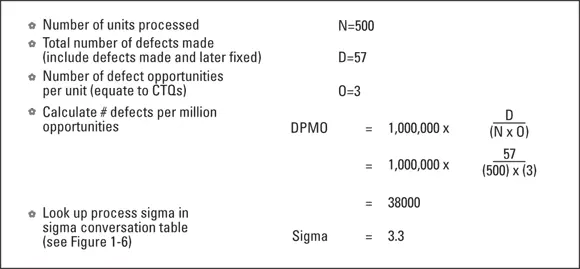Not all organizations using Six Sigma calculate Process Sigma values. Some organizations just use the number of defects or the percentage of orders meeting CTQs to show their performance. Either way, if benchmarking is to be meaningful, the calculations must be made in a consistent manner.
Figure 1-6 includes yield figures — the right first time (or ‘first pass yield’) percentage. You can see that Six Sigma performance equates to only 3.4 DPMO.
Calculating the DPMO for your process measures quality using defects rather than defectives. This is an important distinction that requires more explanation.
Let's say your customer has several CTQs relating to an order — for example not just the speed (cycle time) but also accuracy and completeness. Each CTQ represents a defect opportunity. Thus, more than one defect may occur in the transaction. You could have a situation whereby the speed CTQ was met, but the accuracy and completeness CTQs were missed. The outcome would be one defective delivery (as a result of these two defects ).

© Martin Brenig-Jones and Jo Dowdall
FIGURE 1-6:Abridged Process Sigma conversion table.
In calculating sigma values for your processes, you need to understand the following key terms:
Unit: The item produced or processed.
Defect: Any event that does not meet the CTQ.
Defect opportunity: Any event that provides a chance of not meeting a customer CTQ. The number of defect opportunities will equal the number of CTQs.
Defective: A unit with one or more defects.
You can work out your Process Sigma performance against the CTQs as shown in Figure 1-7. We have a sample of 500 processed units. The customer has three CTQs, so we have three defect opportunities. The CTQs are related to speed, accuracy and completeness. We find 57 defects. With software, you can determine a precise Process Sigma value, but with the abridged table in Figure 1-6, find the sigma value that’s closest to your DPMO number of 38000. As you can see, this is 3.3.

© Martin Brenig-Jones and Jo Dowdall
FIGURE 1-7:Calculating Process Sigma values.
There is a small quirk to be aware of here. A Process Sigma and standard deviation are not quite the same thing. This results from Motorola adjusting the sigma conversion tables to reflect the variation they observed in their processes over the long term, after studying it for several years. The adjustment is referred to as a “1.5 sigma shift,” reflecting the extent of the shift in performance. Although this adjustment related to Motorola’s processes, everyone adopting Six Sigma has also adopted the adjusted sigma scale.
When we talk about Six Sigma performance before the adjustment, we’re talking about performance data within plus or minus six standard deviations of the average, which embrace 99.999998 per cent of the data. This is the percentage of cases that are right first time in terms of meeting the requirements of the customer. It equates to 0.002 DPMO! Even with the adjustment, we’re still looking at a truly demanding standard, with 99.999666 per cent of cases right first time in meeting the CTQs.
Bringing Lean and Six Sigma together
A natural synergy exists between Lean and Six Sigma, and your organization needs both. Bringing the two together provides a sound set of principles and a broad set of tools and techniques that can enhance effectiveness and delivery efficiency. We’ll explore this further in Chapter 2.
Lean Six Sigma has evolved significantly since its inception. Today’s Lean Six Sigma is more than a combination of Lean and Six Sigma: It includes Change Management, Project Management, Agility, Design Thinking, and more. In the spirit of Continuous Improvement, it’s fitting to include “the best of the best” frameworks, tools, techniques and approaches in this edition of Lean Six Sigma For Dummies. These firmly establish the ongoing relevance and value of Lean Six Sigma.
But bear in mind the importance of a pragmatic approach. The “new” elements haven’t been included because they sound impressive; they've been included because they work. As with Lean and Six Sigma, we’ll outline some basics here and delve into detail in future chapters.
Lean Six Sigma practitioners should make good use of frameworks, tools, and techniques to manage change, as people’s acceptance and engagement is vital if any change or improvement is going to succeed. Bringing Change Management into Lean Six Sigma can help you to do the following:
Establish and communicate a clear need for change and sense of purpose.
Build engagement with stakeholders.
Develop a vision and a plan that gives people a clear picture of “what’s in it for me.”
Handle resistance and conflict while supporting the team to make change happen.
Embed change by addressing aspects of behavior that could reinforce or hinder it.
Monitor progress.
Communicate effectively to build acceptance and appetite for change.
Chapter 6provides further detail on managing people and change.
Agile has evolved from being something software developers did to becoming recognized as a way of boosting the performance of projects in general. Applying Agile concepts and an Agile mindset to Lean Six Sigma helps to speed up the delivery of improvement results and bring focus and cohesion to a team.
These aspects of Agile are of particular relevance and value:
Focusing on delivering the benefits in a timely way. For example, not releasing all of the changes or deliverables on one hit but doing so in increments, so customers feel the benefits quicker and can provide feedback on what’s working and what’s not. Letting go of perfection is necessary here. In the words of Mark Twain, “Continuous improvement is better than delayed perfection.”
Embracing a culture of experimentation: being prepared to test and try things out and learn from them. You recognize that not everything will work and are comfortable with failure.
Using aspects from the Scrum approach (see Chapter 16) to deliver the Lean Six Sigma work in timely, focused “sprints” of activity rather than letting projects drag on over long periods of time.
Visualizing the “to do” list of a Lean Six Sigma project by using the kanban approach.
Creating an atmosphere of “psychological safety” where team members feel safe, comfortable, and confident to make their contribution.
Agility is a powerful enabler when it comes to Lean Six Sigma. Chapter 16looks at Agile in more detail.
We live in an age of innovation, where customers’ needs and expectations change rapidly and technological advances can make nearly anything possible. Innovation (whether disruptive — the type that creates a dramatic shift away from what’s gone before — or more incremental) can help shape effective responses to changes and opportunities, and create new concepts or processes to excite customers.
The basics of Robotic Process Automation are featured in Chapter 13of this book. There are also some tools for creative thinking and ideas generation that support “thinking differently” (see Chapter 12).
As with all of the new ingredients in today’s Lean Six Sigma mix, there are entire books devoted to this subject. A fantastic summary of the mindset required to drive innovation is provided in the Design Thinking Playbook (authored by Lewrick, Link, and Leifer and published by Wile y). Lean Six Sigma practitioners can benefit greatly from these, and we’ll delve a little deeper into Design Thinking in Chapter 15.
Читать дальше














